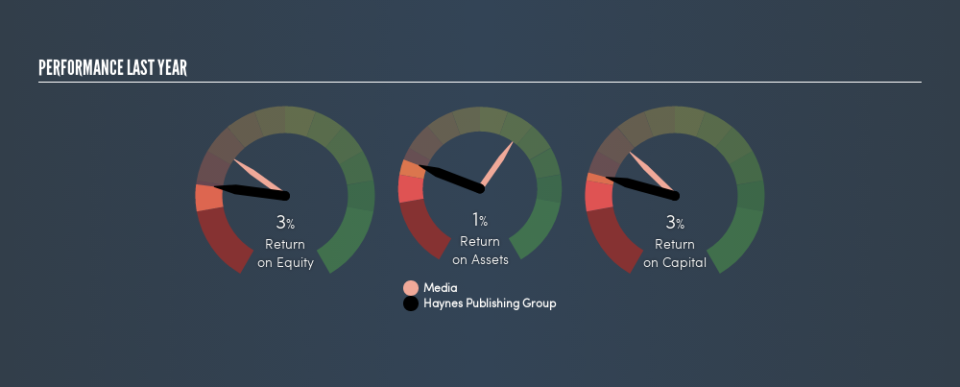Why Haynes Publishing Group P.L.C.’s (LON:HYNS) Return On Capital Employed Might Be A Concern

Want to participate in a short research study? Help shape the future of investing tools and receive a $20 prize!
Today we’ll look at Haynes Publishing Group P.L.C. (LON:HYNS) and reflect on its potential as an investment. Specifically, we’ll consider its Return On Capital Employed (ROCE), since that will give us an insight into how efficiently the business can generate profits from the capital it requires.
First up, we’ll look at what ROCE is and how we calculate it. Second, we’ll look at its ROCE compared to similar companies. Then we’ll determine how its current liabilities are affecting its ROCE.
Return On Capital Employed (ROCE): What is it?
ROCE measures the amount of pre-tax profits a company can generate from the capital employed in its business. In general, businesses with a higher ROCE are usually better quality. In brief, it is a useful tool, but it is not without drawbacks. Renowned investment researcher Michael Mauboussin has suggested that a high ROCE can indicate that ‘one dollar invested in the company generates value of more than one dollar’.
How Do You Calculate Return On Capital Employed?
The formula for calculating the return on capital employed is:
Return on Capital Employed = Earnings Before Interest and Tax (EBIT) ÷ (Total Assets – Current Liabilities)
Or for Haynes Publishing Group:
0.03 = UK£2.6m ÷ (UK£61m – UK£12m) (Based on the trailing twelve months to November 2018.)
Therefore, Haynes Publishing Group has an ROCE of 3.0%.
Check out our latest analysis for Haynes Publishing Group
Does Haynes Publishing Group Have A Good ROCE?
One way to assess ROCE is to compare similar companies. We can see Haynes Publishing Group’s ROCE is meaningfully below the Media industry average of 9.0%. This performance is not ideal, as it suggests the company may not be deploying its capital as effectively as some competitors. Independently of how Haynes Publishing Group compares to its industry, its ROCE in absolute terms is low; especially compared to the ~1.2% available in government bonds. It is likely that there are more attractive prospects out there.
Haynes Publishing Group’s current ROCE of 3.0% is lower than its ROCE in the past, which was 6.5%, 3 years ago. Therefore we wonder if the company is facing new headwinds.
When considering ROCE, bear in mind that it reflects the past and does not necessarily predict the future. ROCE can be deceptive for cyclical businesses, as returns can look incredible in boom times, and terribly low in downturns. ROCE is only a point-in-time measure. Future performance is what matters, and you can see analyst predictions in our free report on analyst forecasts for the company.
What Are Current Liabilities, And How Do They Affect Haynes Publishing Group’s ROCE?
Liabilities, such as supplier bills and bank overdrafts, are referred to as current liabilities if they need to be paid within 12 months. Due to the way ROCE is calculated, a high level of current liabilities makes a company look as though it has less capital employed, and thus can (sometimes unfairly) boost the ROCE. To counteract this, we check if a company has high current liabilities, relative to its total assets.
Haynes Publishing Group has total liabilities of UK£12m and total assets of UK£61m. Therefore its current liabilities are equivalent to approximately 20% of its total assets. With a very reasonable level of current liabilities, so the impact on ROCE is fairly minimal.
Our Take On Haynes Publishing Group’s ROCE
Haynes Publishing Group has a poor ROCE, and there may be better investment prospects out there. You might be able to find a better buy than Haynes Publishing Group. If you want a selection of possible winners, check out this free list of interesting companies that trade on a P/E below 20 (but have proven they can grow earnings).
For those who like to find winning investments this free list of growing companies with recent insider purchasing, could be just the ticket.
We aim to bring you long-term focused research analysis driven by fundamental data. Note that our analysis may not factor in the latest price-sensitive company announcements or qualitative material.
If you spot an error that warrants correction, please contact the editor at editorial-team@simplywallst.com. This article by Simply Wall St is general in nature. It does not constitute a recommendation to buy or sell any stock, and does not take account of your objectives, or your financial situation. Simply Wall St has no position in the stocks mentioned. Thank you for reading.

 Yahoo Finance
Yahoo Finance 
